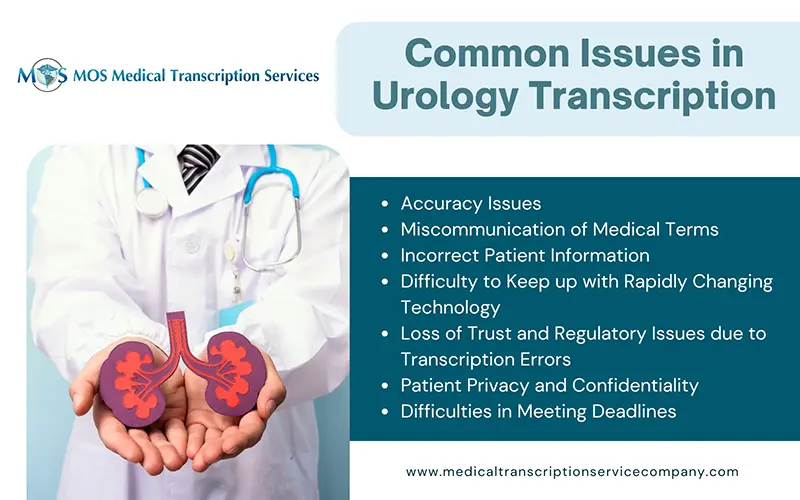
Table of Contents
Urology-specific transcription involves transcribing and intricate medical terms, procedures, and diagnoses into error-free records that healthcare providers can rely on for effective patient care. However, urology documentation presents several medical transcription challenges. From navigating accuracy issues to safeguarding patient confidentiality, the hurdles can significantly impact the quality and timeliness of transcription. Professional medical transcription services are important for addressing these challenges and by offering expertise, compliance, and reliable turnaround times they enable healthcare providers to focus on their patients.
Urology medical reports transcription involves documenting the following:
- Patient history and physicals
- Consultations
- Progress notes
- Discharge summaries
- Operative notes
- Radiology reports
- Pathology reports
Accurate and error-free documentation enables healthcare providers to provide optimum patient care while maintaining compliance and efficiency.

Challenges in Urology Transcription
When it comes to urology-specific terminology, the transcription process poses unique challenges. Accurately transcribing these specialized terms requires a high level of expertise, attention to detail, and a thorough understanding of medical language. Here are some of the primary challenges associated with ensuring transcription accuracy in urology:
- Accuracy Issues: Precision is critical in urology transcription, as even minor errors can have severe consequences. Urology-specific terms, such as “cystoscopy” or “urodynamics,” are not only complex but often similar in pronunciation to other medical terms. Mishearing or misinterpreting these terms can result in flawed documentation, leading to diagnostic or treatment errors. This calls for the services of transcriptionists with specialized training in urology.
- Miscommunication of Medical Terms: Urology transcription involves interpreting detailed medical terminology, abbreviations, and jargon. Miscommunication or incorrect transcription of terms like “BPH” (benign prostatic hyperplasia) or IVP (Intravenous Pyelogram) can lead to inappropriate treatments or medication errors.
- Incorrect Patient Information: Errors in transcribing patient details, such as names, dates of birth, or medical history, can have serious consequences. For example, incorrect transcription of a patient’s diagnosis or treatment plan could lead to mismanagement or procedural errors. Ensuring the accuracy of patient information is critical in urology, as the field often involves highly specific diagnostic and treatment protocols.
- Rapidly Changing Technology and the Fear of Being Left Out: The medical field, including urology, is constantly evolving with new technologies and techniques. Transcriptionists must stay updated on emerging treatments, such as robot-assisted surgeries or new diagnostic tools, to ensure accuracy. Additionally, the integration of speech recognition software in transcription has introduced challenges, as these systems often fail to interpret complex urological terms accurately. While AI provides speed, it often lacks the precision required for medical documentation.
- Loss of Trust and Regulatory Issues Due to Transcription Errors: Errors in medical transcription can erode trust between patients and healthcare providers. For instance, a misstep in transcribing a surgical report or diagnostic result can raise questions about the provider’s competence. Furthermore, transcription errors may result in non-compliance with regulations such as HIPAA, exposing healthcare organizations to legal liabilities and penalties.
- Patient Privacy and Confidentiality: Urology transcription involves handling sensitive patient information, such as diagnoses of prostate cancer or bladder disorders. Ensuring data security and maintaining confidentiality is a significant challenge, especially with the growing threat of cyberattacks. Medical transcriptionists must comply with strict regulations, such as HIPAA, to protect patient privacy.
- Difficulties in Meeting Deadlines: Urology practices demand quick turnaround times to ensure timely patient care. Balancing speed with accuracy is challenging, particularly when dealing with complex terminology and detailed records. Transcriptionists must manage their workload efficiently while maintaining the high standards required for medical documentation.
How Medical Transcription Services Overcome These Challenges
Transcribing urology-related medical content requires a strong grasp of complex anatomical terminology, abbreviations, and procedure names that are specific to the urinary tract and male reproductive system. With urologists frequently dealing with sensitive, intricate conditions such as prostate cancer, kidney disorders, and urinary incontinence, even minor transcription errors can have serious clinical consequences.
Professional medical transcription services are well aware of the common difficulties in urology transcription and how to overcome them. They have specific strategies in place to improve accuracy in transcribing urology medical terms.
- 1. Solid Foundation in Urology Terminology
Professional transcriptionists are familiar with the most common urology terms, including:
- Anatomical structures: urethra, ureter, prostate, bladder, epididymis
- Conditions: BPH (Benign Prostatic Hyperplasia), cystitis, hydronephrosis, hematuria
- Procedures: TURP, cystoscopy, vasectomy, nephrectomy
They use flashcards, glossaries, or specialty-specific medical dictionaries to reinforce your learning.
- 2. Stay Updated with Urology Abbreviations and Jargon
Urologists often use shorthand or acronyms that may be unfamiliar to general transcriptionists. For example: PSA – Prostate-Specific Antigen, DRE – Digital Rectal Exam, and UTI – Urinary Tract Infection.
Reliable medical transcriptionists maintain a personal abbreviation list and update it regularly as they come across new terms.
- 3. Use Reliable Medical Reference Tools
Professionals leverage trusted resources such as Stedman’s Urology & Nephrology Words, American Urological Association (AUA) website and Merriam-Webster Medical Dictionary. They also use online tools like Drugs.com or Medscape when transcribing medications commonly prescribed in urology.
- 4. Use AutoCorrect and Text Expanders with Caution
Text expansion tools can boost efficiency but can also introduce errors if not properly configured. Professional transcriptionists double-check that expansions accurately reflect the dictated term, especially with similar-sounding words (e.g., ureter vs. urethra).
- 5. Clarify Ambiguous Dictations
Urology reports may include unclear or poorly enunciated dictation. If a term is inaudible or uncertain, transcriptionists will:
- Flag it for review instead of guessing
- Refer to the patient’s history (if accessible) for context
- Check with a supervisor or physician if clarification is allowed
- 6. Understand the Context of the Report
Transcribing a urodynamic study, operative report, or consultation note each requires a different focus. Skilled transcriptionists are knowledgeable about the type of document, which guides them in interpreting terms and ensuring appropriate formatting.
- 7. Practice Spelling and Pronunciation
Many urology terms are derived from Latin or Greek, which can make spelling a challenge. For instance: pyelonephritis, orchiectomy, and cystourethroscopy Reliable medical transcriptionists practice both spelling and pronunciation to improve recognition during dictation.
- 8. Focus on Drug Names and Dosages
Urologists frequently prescribe antibiotics, alpha-blockers, and hormone therapies. Mishearing or miswriting a drug name like tamsulosin or leuprolide can be critical. Professionals verify drug names and dosages using reliable pharmacological resources.
- 9. Review and Proofread Diligently
Medical transcription services have rigorous quality control processes to minimize errors and produce reliable transcripts. They review files, paying close attention to:
- Medical spelling
- Numeric values (especially lab results and dosages)
- Left vs. right side of the body (e.g., left renal calculus)
- 10. Continuously Learn and Get Feedback
Even seasoned transcriptionists ask for regular reviews from QA teams or senior colleagues. They attend urology webinars or read specialty journals to stay in tune with new terms and evolving language in the field.
Skilled teams deliver accurate transcripts within the agreed timelines, supporting timely medical decisions. They ensure HIPAA compliance and confidentiality while adhering to legal standards.
From patient histories and consultations to radiology and pathology reports, every record must be precise to avoid miscommunication and ensure compliance with medical standards. However, the challenges of transcribing urology-specific terminology—such as accuracy issues, tight deadlines, and data confidentiality-require expertise and diligence. Associating with professional medical transcription services ensures high-quality transcripts that meet stringent industry requirements. With expert transcriptionists and robust quality checks, these services enable healthcare providers to focus on patient outcomes while maintaining compliance and efficiency. Healthcare providers who are considering outsourcing medical transcription must work with a provider that complies with HIPAA.
